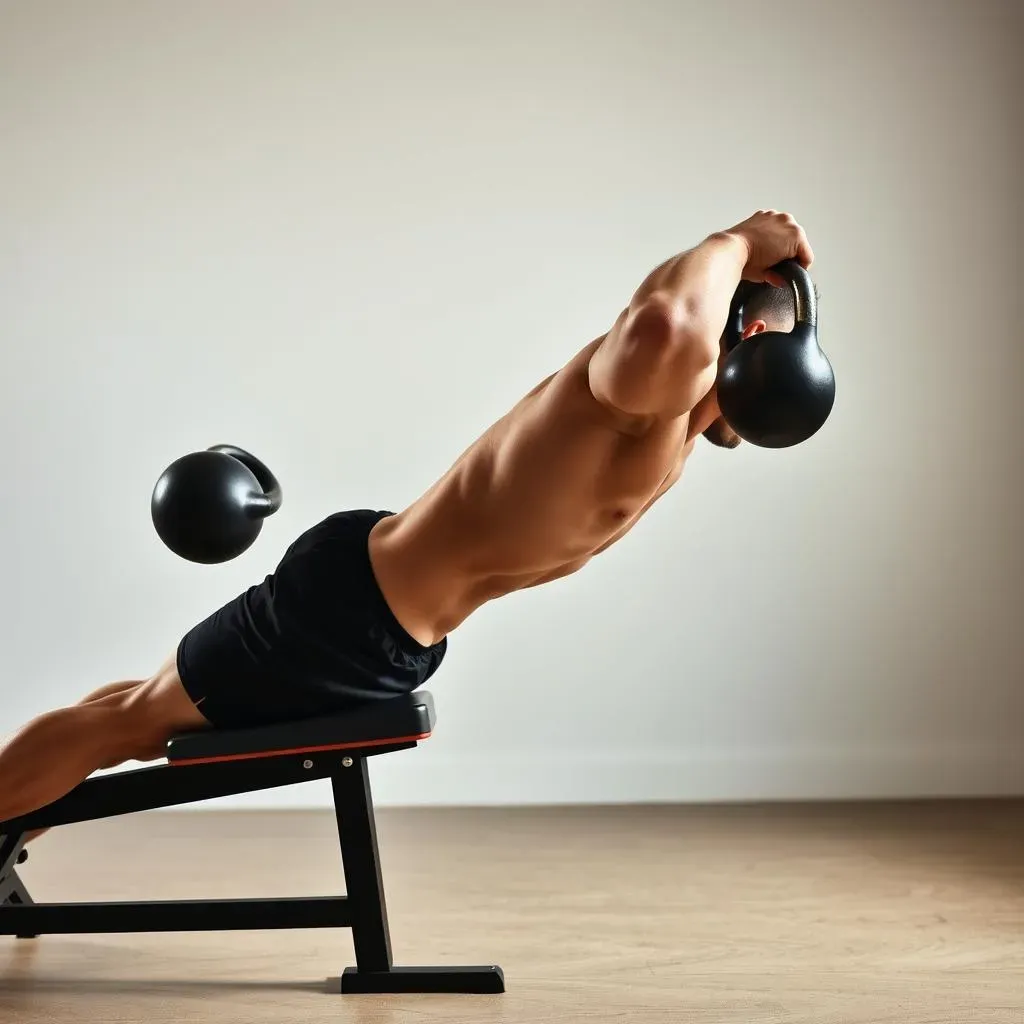Table of Contents
Ready to ditch the boring back exercises and sculpt a powerful, resilient back? You're in the right place. This isn't your typical gym routine; we're diving into the world of kettlebells. A kettlebell workout for back can transform how you move and feel. Forget those clunky machines; kettlebells offer a dynamic way to build strength, improve posture, and boost overall performance. We'll explore the key muscles involved in back training and why kettlebells are a game-changer for this area. Then, I'll share my top 10 favorite kettlebell exercises that will hit every angle of your back. You'll get a sample 4-week program to kickstart your journey, complete with details on how to progress. So, grab a kettlebell, let's get started, and get ready to experience a stronger, more capable back!
Back Anatomy: Muscles Worked in a Kettlebell Workout

Back Anatomy: Muscles Worked in a Kettlebell Workout
Alright, let's talk back muscles – not just the ones you see in the mirror, but the whole crew working together. When you're doing a kettlebell workout for your back, it's not just one muscle doing all the work. We're talking about a symphony of muscles firing up to keep you stable, strong, and moving smoothly. You've got your lats, those big wings that run down your sides, doing a lot of the heavy lifting when you pull. Then there are the erectors, the long muscles that run along your spine, keeping you upright and powerful. Don't forget the smaller guys like the rhomboids, between your shoulder blades, and the traps, which stretch from your neck down your back. These all play a vital role in a good back workout. And, of course, your biceps get a little love when you're pulling that kettlebell.
Why Kettlebells Are Great for Your Back

Why Kettlebells Are Great for Your Back
Okay, so you know the back muscles are a team, but why use kettlebells instead of, say, dumbbells or a barbell? Well, kettlebells are like the Swiss Army knife of fitness. Their unique shape and off-set weight make them awesome for back work. Because the weight isn't evenly distributed, your muscles have to work harder to stabilize and control the kettlebell. This engages more of your core and back muscles, leading to a more effective workout. Think about it: a dumbbell is balanced, but a kettlebell challenges you in every direction. Plus, kettlebells are fantastic for dynamic movements, like swings and cleans, that really fire up your back in ways that other equipment can't match.
The handle design also plays a big role. It allows for a more natural grip, which is easier on your wrists and lets you move more fluidly through exercises, reducing the risk of injury. Plus, there is something satisfying about swinging a kettlebell, it feels more like a movement than just lifting a weight. It's like dancing with a cannonball, and who doesn't want to dance with a cannonball?
Benefit | Why It Matters |
|---|---|
Dynamic Movements | Engages more muscles, improves coordination. |
Off-Set Weight | Forces stabilization, strengthens core & back. |
Natural Grip | Easier on wrists, reduces risk of injury. |
Versatility | Great for a range of exercises, from rows to swings. |
Top 10 Kettlebell Exercises for a Stronger Back

Top 10 Kettlebell Exercises for a Stronger Back
Kettlebell Rows: The Back Builder
Alright, let's get into the good stuff - the exercises! First up, we have the kettlebell row, a powerhouse for your back. It's like giving your back a big, strong handshake. You can do these in a few ways: single-arm rows, chest-supported rows, and even gorilla rows. For a single-arm row, you'll hinge at your hips, keeping your back straight, and pull the kettlebell towards your ribcage. Imagine you're trying to squeeze a pencil between your shoulder blades at the top of the movement. Chest-supported rows are great because they take the strain off your lower back. You'll lean against a bench or something stable, and row the kettlebell with one arm. Gorilla rows are a bit more advanced where you are in a plank position and row the kettlebell with one arm at a time. No matter which row you choose, this movement is fantastic for building those lats and rhomboids.
Think of it like this: you're not just pulling a weight; you're pulling your shoulder blades together, really working those muscles that keep your posture looking sharp and your back feeling strong. Keep your core tight, and don't let your back round. Start with a weight that feels challenging but manageable, and focus on perfect form before going heavier. Remember, it's about quality, not just quantity. These rows are like the bread and butter of any good kettlebell workout for back.
Deadlifts, Swings, and More: The Full Back Workout
Next on the list, we've got kettlebell deadlifts, the king of all exercises, really. This isn't just about lifting something heavy off the ground; it's about engaging your entire posterior chain, from your hamstrings to your lower back to your traps. Make sure you're hinging at your hips and keeping your back straight and not rounding. Then, there are kettlebell swings, which are like a party for your back muscles. It's a dynamic movement that uses momentum to work your core, glutes, and back. The key is to generate the power from your hips, not your arms. Think of it as a hip hinge with a weight attached, not a squat. Other great exercises include single-leg RDLs, which will challenge your balance and core, pullovers, which are awesome for stretching and strengthening the back, farmer's carries, which are great for grip strength and core stability, and alternating renegade rows, which are a more advanced version of the rows we talked about earlier. Don't forget cleans and back extensions to round out the workout.
These exercises are like the spice rack of a good workout; they add variety and hit your back from different angles. Incorporating a mix of these movements ensures that you're not just building strength but also improving your mobility and overall function. Start slow, focus on your form, and don't be afraid to modify exercises to fit your level. The goal is to create a well-rounded routine that keeps your back strong and healthy for the long haul.
Exercise | Main Benefit | Why It's Great |
|---|---|---|
Single-Arm Row | Builds lats and rhomboids | Improves posture and upper back strength |
Deadlift | Engages posterior chain | Strengthens hamstrings, lower back, and traps |
Kettlebell Swing | Works core, glutes, and back | Dynamic movement, great for conditioning |
Single-Leg RDL | Challenges balance and core | Improves stability and hamstring strength |
Pullovers | Stretches and strengthens back | Enhances flexibility and back strength |
Farmer's Carry | Builds grip and core strength | Improves overall stability and posture |
Renegade Row | Advanced core and back | Works on core stability and back muscle |
Cleans | Full body power movement | Great for building power and explosiveness |
Back Extensions | Strengthens lower back | Improves posture and lower back health |
A Sample 4Week Kettlebell Back Workout Routine

A Sample 4Week Kettlebell Back Workout Routine
Getting Started: The First Two Weeks
Alright, let's map out a 4-week plan to get your back stronger than ever. For the first two weeks, we're going to focus on building a solid foundation. Think of it like laying the bricks for a house, we need to make sure everything is in the right place before we start adding more weight and complexity. You'll be doing exercises like kettlebell deadlifts, single-arm rows, and back extensions. Start with a weight that feels comfortable, and focus on really nailing the form. Remember, it's better to do fewer reps with good form than many reps with bad form. We're aiming for 3 sets of 8-12 repetitions for each exercise. This is not a race, we are building a sustainable workout plan here, so take your time. Rest for about 60 seconds between sets. The goal here is to get your body used to the movements and build some initial strength.
Make sure your core is engaged throughout the exercises. When doing deadlifts, imagine you're pushing the floor away with your feet. For rows, focus on pulling your shoulder blades together. Back extensions should feel like you are lengthening your spine and squeezing your glutes at the top. This is not about ego lifting; this is about building a rock solid base for future progress. Don't be afraid to scale back the weight if you feel like your form is slipping, it is okay. Listen to your body, and don't overdo it. The first two weeks are all about learning and getting comfortable. Now is the time to really understand the movement and how it feels in your body.
Progressing: Weeks Three and Four
Now that you've got the hang of the basic movements, it's time to turn up the heat for weeks three and four. We're still doing deadlifts, rows, and back extensions, but we're going to add kettlebell cleans and pullovers to the mix. These exercises will challenge you a bit more and help you build more power and muscle. For the cleans, focus on the hip hinge and explosion, and try not to use your arms too much to lift the kettlebell. The key is to catch the kettlebell in a rack position, using your hips, and not your arms. Pullovers are great for stretching and strengthening your back. You'll lie on your back with a kettlebell in your hand, and lower it behind your head, keeping a slight bend in your elbows. We're still doing 3 sets, but now we're going for 6-10 reps, and we're going to increase the weight if you feel like you can do so with good form. It's time to push yourself a little, but always in a smart and controlled way.
This is where the magic really happens, you will start to feel the improvement in your overall strength and fitness. Continue to focus on your form, and don't be afraid to adjust the weight as needed. If you feel like you are struggling to maintain your form, reduce the weight, it's better to do it right than to do it heavy. By the end of the four weeks, you should feel stronger, more confident, and ready to tackle more challenging workouts. Remember, consistency is key. Stick with the routine, listen to your body, and you'll see results. We're not just building a strong back; we're building a stronger you. Now, let's get to work!
Week | Exercises | Sets | Reps | Focus |
|---|---|---|---|---|
1-2 | Deadlifts, Rows, Back Extensions | 3 | 8-12 | Form and technique |
3-4 | Deadlifts, Rows, Back Extensions, Cleans, Pullovers | 3 | 6-10 | Increase weight/intensity |
Wrapping Up Your Kettlebell Back Journey
So, there you have it—a comprehensive guide to using kettlebells for a stronger, healthier back. We've covered the muscles involved, why kettlebells are so effective, and gave you ten killer exercises to add to your routine. Remember, consistency is key. Don't expect to become a back-bending superhero overnight. Start with a weight that challenges you but still allows you to maintain good form. As you get stronger, gradually increase the weight or reps. The 4-week workout plan is a solid starting point, but feel free to adjust it to fit your own needs and goals. Kettlebells aren't just about lifting weights; they're about learning to move better, feel stronger, and become more resilient in your everyday life. Now, go lift something heavy and make your back proud!